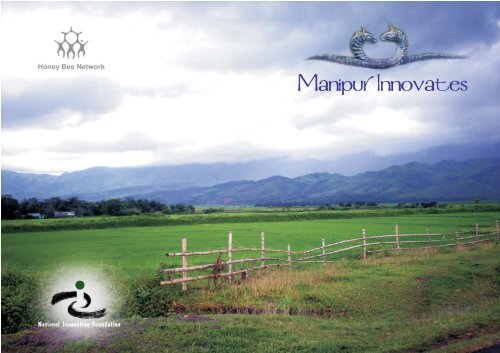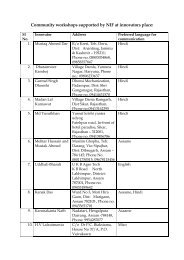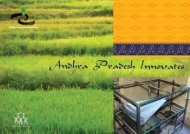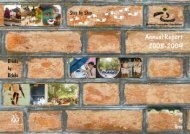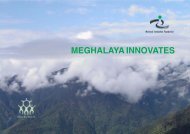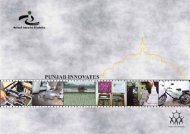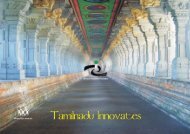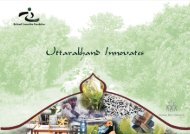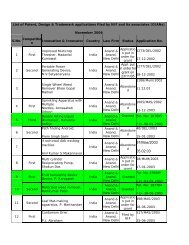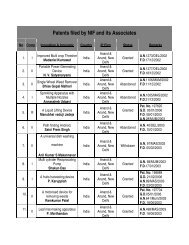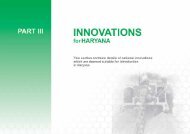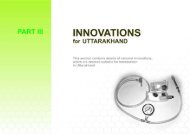PART-I Manipur.pmd - National Innovation Foundation
PART-I Manipur.pmd - National Innovation Foundation
PART-I Manipur.pmd - National Innovation Foundation
- No tags were found...
You also want an ePaper? Increase the reach of your titles
YUMPU automatically turns print PDFs into web optimized ePapers that Google loves.
PREFACE<strong>National</strong> <strong>Innovation</strong> <strong>Foundation</strong> (NIF) has been pursuing themission of making India innovative and a creative societysince 2000 with the active support of Department of Scienceand Technology, Government of India. Till date NIF has beenable to scout innovations and traditional knowledge practicesfrom over 520 districts across India.Thanks to the support of volunteers from Honey Bee Network,we have been able to discover many unsung heroes andheroines of our society who have solved local problemswithout any outside help.Despite various constraints, NIF has put together a small bookcelebrating creativity, innovation and traditional knowledgefrom <strong>Manipur</strong>. I am conscious of its limitation in terms ofcoverage and outreach. But if we could uncover at least afew examples of the ability of local communities andindividuals to solve problems on their own without outsidehelp, how much more can be done if state and private sectoragencies join hands with NIF actively.I invite the state government and its various organs to activelysupport our quest to uncover many more creative communitiesand individuals in rural and urban areas. NIF will then helpin building value chain around them.The book is divided in three parts. The mechanical innovationsdeveloped by innovators from <strong>Manipur</strong> are covered in partone. Selected examples of herbal traditional knowledge aregiven in part two. The innovations from other parts of thecountry suitable for the development of <strong>Manipur</strong> are givenin part three.By no stretch of imagination, could we claim that we haveachieved a great deal. We have merely made a simple point.There are a large number of knowledge rich people whoMANIPUR INNOVATES 4
MANIPUR INNOVATESmay not have been educated much, may in fact beeconomically poor also, but still have the ability to solve afew problems so well.The challenge really is to work out a synergy so that nocreative voice remains unheard, and no solution remainslocalized and unrecognized. By adapting public policy insupport of grassroots innovators and traditional knowledgeholders, we can make economic development process moreinclusive and sustainable.This book on innovations has been compiled at the requestof Dr. Vijay Kelkar, Chairman, Finance Commission and theMember, Governing Council of the <strong>National</strong> <strong>Innovation</strong><strong>Foundation</strong> as a tribute to the creativity and innovation atgrassroots. This presentation is part of a series of innovationcompendium prepared for every State of India. We hopethis will be followed up in the form of concrete policy andinstitutional initiatives in each State to empower creativepeople to improve the quality of life of common people andthus promote inclusive growth.It is my belief that such examples will act as spur for otherState government departments to look for creative efforts oftheir staff and users at ground level. I hope that NIF willhave the opportunity to work closely with the State governmentin future and expand knowledge base, add value to selectedtechnologies and help them diffuse through commercial andnon-commercial social channels for improving the livelihoodof the majority of the people.R. A. Mashelkar, FRSChairperson, Governing Council<strong>National</strong> <strong>Innovation</strong> <strong>Foundation</strong>, Ahmedabadmashelkar@nifindia.orgMANIPUR INNOVATES 5
Building a Bridge with Grassroots Innovators in Informal SectorTo make the Indian development process more inclusive, thereis no escape from building upon creative and innovativeexperiments pursued by common people at village or semiurbanlevel. Many of these experiments lead to development ofinnovations, which can improve productivity and generateemployment. However, the purpose of a particular innovatormay often be to solve just his/her problem. There is nomechanism available for him to share the knowledge, innovationor practice with other people in different regions. Sometimes,ideas and innovations get diffused through word of mouth. Butmany times, these ideas remain localized. In the process,potential growth and social development gets constrained. Toovercome this constraint, Honey Bee Network with a handful ofvolunteers triggered a movement, twenty years ago to scout,spawn and sustain the unaided innovations and outstandingtraditional knowledge from the informal sector of our country.Drawing upon this experience, <strong>National</strong> <strong>Innovation</strong> <strong>Foundation</strong>(NIF) was set up in 2000 with the help of Department of Scienceand Technology, Government of India to scale up the idea oflearning from grassroots innovators.Under the inspiring leadership of Dr. R. A. Mashelkar,Chairperson NIF and former Director General, Council ofScientific and Industrial Research (CSIR), NIF has taken majorinitiatives to serve the knowledge-rich, economically poor peopleof the country. It is committed to make India innovative bydocumenting, adding value, protecting the intellectual propertyrights of the contemporary unaided technological innovators,as well as of outstanding traditional knowledge holders. It aimsat promoting lateral learning among local communities togenerate low cost affordable solutions of the persistent andemerging problems, and enhance the diffusion of innovationson a commercial as well as non-commercial basis.How does NIF work?Primarily, NIF has five functions: (a) Scouting anddocumentation, (b) Value addition and research and1 The Honeybee collects pollen from the flowers but they are not impoverished,in the process links one flower to another enabling cross-pollination. Similarly,the Honey Bee Network strengthens people-to-people contacts, learning andnetworking by pooling the solutions developed by individuals across the worldMANIPUR INNOVATES 6in different sectors. The network acknowledges the innovators, traditionalknowledge producers and communicators so that they do not remainanonymous.
MANIPUR INNOVATESdevelopment, (c) Business development and Micro Venture, (d)Intellectual Property Rights protection and (e) Dissemination,database development and IT applications.NIF has been entrusted with the responsibility of building a<strong>National</strong> Register of Grassroots <strong>Innovation</strong>s and TraditionalKnowledge. It is not enough to document or disseminate theinnovations or outstanding traditional knowledge. Value additionis very important for harnessing the full potential of the idea.NIF has entered into MOU with CSIR and Indian Council ofMedical Research (ICMR) besides other organizations. CSIRhas allocated funds to support research on grassrootsinnovations in CSIR labs. Similarly, ICMR supportsresearch on such herbal healing knowledge, whichhas not been documented in the classical texts and formalinstitutional literature. NIF also helps in generating a very largepool of open source / public domain technologies. A smallnumber of innovations are also protected by patents andother IPRs.For most innovators, attracting risk capital for convertinginnovations into enterprise is very difficult. They neither canoffer much collateral nor are they able to develop a businessplan or deal with formal R&D system.A Micro Venture <strong>Innovation</strong> Fund (MVIF) has been set up withthe help of SIDBI to provide risk capital for technologies atdifferent stages of incubation. Under single signature, innovatorsare trusted and investments are made to help them commercialisetheir innovations. Most innovators do not make good entrepreneurs.For entrepreneurship, one has to make consistent batch bybatch production of products. Innovators are often incorrigibleimprovisers. They seldom make two things alike. NIF has helpedsuch innovators to license their technologies to third partyentrepreneurs. Most of the licenses have been given to smallentrepreneurs and in a few cases, to medium enterprises.A very elaborate benefit sharing system has been developed,governed by the Prior Informed Consent (PIC) of the knowledgeThe Honey Bee Network strongly believes in sharing knowledge among theproviders of innovations in their own language, which is achieved by publishinglocal language versions of Honey Bee newsletter. It also ensures that a fairshare of benefits arising from commercial exploitation of local knowledge andinnovations reaches the innovators and knowledge providers.MANIPUR INNOVATES 7
providers. Attempt is made to share benefits not only with theinnovators but also with their communities and for natureconservation. In addition, a small part is kept for contingencysupport to needy innovators, for R&D stakeholders, promotingwomen’s innovations and meeting overhead costs.It is remarkable that grassroots innovations are generating globaldemand, as evident from inquiries from around fifty-five countriesfor various technologies, NIF has succeeded in commercializingproducts across countries in six continents apart from beingsuccessful in materialising thirty cases of technology licensingwith the help of partner agencies.What has it done?With major contribution from the Honey Bee Network, NIF hasbeen able to build up a database of more than 1,00,000 ideas,innovations and traditional knowledge practices (not all unique,not all distinctive) from over 520 districts of the country.NIF has filed 182 patents in India and seven in US and one PCTapplication. Out of these, 33 patents have been granted tograssroots innovations in India and four in US. NIF has funded113 projects under MVIF to the extent of Rs.1.3 crores. Hundredsof technologies have diffused through farmer to farmer socialnetwork.NIF has proved that Indian innovators can match anyone in theworld when it comes to solving problems creatively. Where theyperform better than rest is in generating more affordablesustainable solutions by using local resources frugally.Those who see poor only as the consumer of cheap goods, missthe knowledge richness at the grassroots level. The Poor can bethe Providers also.The Grassroots to Global (G2G) model that NIF is propagating isall set to change the way the world looks at the creativity andinnovations at grassroots.How can state government join hands with NIF?a. NIF has no field extension unit nor does it want to haveone. However, state government has several fieldfunctionaries in the area of agriculture, education, industry,rural development, women and child care, forestry, etc.There can be a very fruitful partnership between NIF as aMANIPUR INNOVATES 8
MANIPUR INNOVATESsource of innovative ideas and technologies and stategovernment as partner in dissemination, value addition andeven commercialization through incentives, promotion,subsidies, etc.b. State government can join the national campaign forscouting innovations and traditional knowledge and motivateits grassroots functionaries to join hands with NIF inuncovering the talent at the community level.c. Students in schools and colleges can be motivated to scoutcreative and innovative people in their neighbourhoodsand send the entries to NIF (Post Box No.15051, Ambavadi,Ahmedabad 380 015, campaign@nifindia.org). Examplesof innovations can also be included in the curriculum forthe school and college education.d. Demonstrations and trials can be organized at variousregional research stations and KVKs (Krishi VigyanKendras) so as to create awareness about the creativepotential of common people.e. The research institutions can be mandated to add value tothe knowledge of innovative people and help in protectingtheir knowledge rights.f. On the state’s website, link to NIF can be given and theinnovations from the region can be displayed to put forwardthe creative face of the state before the people.g. Some of the innovative people identified by NIF and/orstate government could be awarded at district and statelevel besides giving them support for further work.h. A nodal officer could be appointed to keep in dynamictouch with NIF to ensure that all the areas of possiblecooperation are explored.I hope that NIF would be able to develop a functional, fruitful andfulfilling relationship with the state of <strong>Manipur</strong>. Tremendouslyrich knowledge of biodiversity and environment besides numerousgrassroots innovations can be leveraged through the proposedcollaboration.Anil K GuptaExecutive Vice Chairperson, NIF, AhmedabadProfessor, Indian Institute of Management,Ahmedabadanilg@nifindia.orgMANIPUR INNOVATES 9
“<strong>Innovation</strong> opens up new vistas of knowledge and newdimensions to our imagination to make everyday lifemore meaningful and richer in depth and content”.- Dr. A.P.J. Abdul Kalam“The purpose of innovation is to create a new value foran individual, team, organization or for society at large”.- Dr. R.A. Mashelkar
01<strong>PART</strong> I : INNOVATIONS FROM MANIPURAutomatic Pump Operator, dehydrator, AgarbatiDhoop making machineM. Manihar SharmaImphal EastM. Manihar Sharma (62), a high school pass, has solved many local problems. Afterdropping out of high school he worked as a local mechanic in a workshop from wherehis fascination with mechanical world began. His journey is diverse; he was a foundergeneral secretary of The All <strong>Manipur</strong> Auto Rickshaw Owner’s and Driver’s Association.He also ran a hotel, served as assistant to his doctor friend and is now a full timeinnovator.He has come up with a Automatic Pump Operating system (APO) with seven variants,which allows hassle-free household water management. Using a central control panel,the pump switches on automatically as soon as the overhead reservoir goes below thethreshold level and switches off as soon it gets full. The same principle follows for theground reservoir as well.MANIPUR INNOVATES 12
<strong>PART</strong> I : INNOVATIONS FROM MANIPURThe innovator has also made a simple dehydrator with very efficient mechanism. Hot airis blown into the chamber with the help of normal heating rods and air blower from below.Every layer of trays is attached with an air guide, which provides uniform distribution ofthe hot air. On top of the machine, an exhaust fan continuously drains out the moisturefrom inside.Manihar has also developed an Agarbati Dhoop making machine. The device has twoblade arrangements, one for making small bamboo splints and the other for making smallsticks. For stick making it has multi-bladed arrangements for different stick sizes. Boththe blades are fixed on two sides of a small wooden bloke. Apart from the above solutions,the innovator has also innovated a micro drill for small operations.MANIPUR INNOVATES 13
02<strong>PART</strong> I : INNOVATIONS FROM MANIPURKouna mat making machineYenkhom Mangi SinghThoubalY. Mangi Singh, a 63 year old physically challenged person, has been able to providethe much needed impetus to the traditional Kouna (water reed) mat making industry in<strong>Manipur</strong>. Kouna is synonymous with the exotic craft tradition of <strong>Manipur</strong>; the uniquefeature is that <strong>Manipur</strong> is the only place where Kouna is grown and extensively used inlocal crafts. More than 4 lakh people in the unorganized sector are engaged in the statecrafts industry and more than 180 items are made using Kouna.This manual machine, which can even be operated by a low skilled worker or a physicallychallenged person can weave two mats per day. The quality of the mats produced isbetter than those produced by traditional methods.The innovator has been financially supported for product development and marketresearch. NIF has also engaged local designers, Nehru Yuva Kedra, Central Crafts officeetc., for value addition and dissemination of this technology.MANIPUR INNOVATES 14
<strong>PART</strong> I : INNOVATIONS FROM MANIPUR03Domestic mini rice millThis innovative compact rice mill developed by Biren performs three different functions –husking, polishing, and vibration, for rice husking. The machine is run by a one HP motorwith an average capacity of milling 100kg of paddy per hour. The unique feature of themachine is the conversion of a normally horizontal husking or milling apparatus into avertical one saving space and making the machine compact.K. Biren Singh*Imphal*As per its mandate, NIFdoes not consider suchprofessionals for awards orfinancial support, but onlyhelps in providing visibilityor linkages.MANIPUR INNOVATES 15
04<strong>PART</strong> I : INNOVATIONS FROM MANIPURVertical hydraulic pumpT. Madhu ChandraImphal WestThis is a hydraulic pressure pump for bending iron rods. Normally the available pumpsare placed horizontally, which takes more space. This also creates a lot of problems forthe user. As the piston moves horizontally, the iron rod to be bent has to be held tightlyhorizontally against the hydraulic force, which becomes quite awkward anduncomfortable for the user. The innovator has solved these problems by making thepressure pump vertical. He has also made a machine for cleaning engine valves, whichcan clean around twenty valves per day.MANIPUR INNOVATES 16
<strong>PART</strong> I : INNOVATIONS FROM MANIPUR05Woolen scarf knitting deviceThis is a very simple but useful innovation to knit woolen scarves. The device consists ofa wooden rectangular base with nails fitted around an inner smaller rectangle. The spacebetween the nails depends on the design of the pattern desired. The desired frill designis made by tying threads to the nails. Thereafter, based on the design, woolen thread isknitted over the nails. The threading of the woolen threads forms a net without any knots.In each nail, there are two threads, one above the other. To make knitting continuous, thelower thread is picked, using a knitting hook, and put on top of the upper thread with across-over around each nail to ensure continuity of the knitted portion. The knitted part ispulled down from below, so that only one layer of knitted thread remains. Then the sameprocess is followed until the desired length of the scarf is obtained.MoirangthemManglembi DeviImphalThis device makes knitting very easy for even the unskilled people and faster thantraditional hand knitting. It can also make double layer pattern cloth or reversible designwith no edge stitching.MANIPUR INNOVATES 17
06<strong>PART</strong> I : INNOVATIONS FROM MANIPURThe shock-proof converterKshetrimayumNicholson SinghImphalAn electric shock occurs when a person comes into contact with an electrical energysource. The present innovative device converts all electrical lines to shock-free powerlines. This is a very useful device for every household/commercial establishment withelectrical installation. The device can be installed just after the energy meter so thateach and every connection in a household/commercial establishment gets connectedto the device and becomes shock-free.Nicholson is a prolific innovator and has many other innovations to his credit like thereuse of fused tube lights, longer lasting modified tube light choke, and movable solarenergy panel.MANIPUR INNOVATES 18
<strong>PART</strong> I : INNOVATIONS FROM MANIPUR07‘Molom Angouba’: a traditional knowledge basedherbal micro-enterprise‘Molom Angouba’ literally means ‘White Ointment’. This is a medicinal ointment preparedusing various local indigenous plants and materials. The paste is mainly used in treatingburn injuries, but can also be used as an antidote for insect bites (especially bees), andas a crack cream.The practitioner, Smt Konsam Shama Devi, inherited the formulation of the medicinefrom her paternal aunt, who had no male heir. Her aunt in turn inherited the knowledgefrom her grandfather. Her grandfather learnt the knowledge from a local medicinalpractitioner named Luwangshangbam Maiba from Luwangshangbam, a small village inthe northern part of Imphal, in the nineteen thirties. The ointment is supposed to cure anyburn injury removing all scars and also offer instant pain relief.Smt. Konsam ShamaDeviImphalKonsam claims to have treated and cured many patients who came out of hospitals uncuredfrom different parts of the state. The ointment has even been sent all the way toDelhi and other states to treat <strong>Manipur</strong>i patients who live there. NIF has provided financialassistance for scaling up her enterprise.MANIPUR INNOVATES 19
08<strong>PART</strong> I : INNOVATIONS FROM MANIPURIron mesh for drying fishN. Indrakumar Singh is a 70 years old carpenter who does agriculture work as well. Hehas no formal education but is a well informed person. He has developed quite a fewmachineries and specializes in making local loom machines.N. Indrakumar SinghToubalSmoking or drying of fish is an age old practice. One such method, which is very popularin the state of <strong>Manipur</strong>, is using of an iron mesh for smoking or burning off the fish scales.In early days, people used to make different kinds of bamboo mesh for such purposes.Now-a-days iron mesh, which is more durable, has become more popular.The present innovation is a simple treadle loom machine to make iron mesh. It is quitesimilar to any other normal treadle loom, except that the new loom has four wheels andmoves along as one weaves along. The machine is the only one of its kind for makingiron mesh. It is low cost, and doesn’t need an expert hand to operate. Each machineprovides employment to about 3-4 people.Besides the iron mesh making machine, the innovator has also developed a small deviceto make patterns on charcoal chula, Frill making machine of iron mesh, Wood curvingtechnique, etc. The innovator has been given financial assistance for product developmentanddissemination forhis machine.MANIPUR INNOVATES 20
<strong>PART</strong> I : INNOVATIONS FROM MANIPUR09Herbal soapKhumujam ( 56), only tenth standard pass, is a prolific innovator, a good craftsman andabove all a good samaritan. She regularly provides training to various individuals, NGOs/SHGs, institutions, etc., in various activities like soap making, agarbatti making,embroidery, bag making from recycled materials, etc.Her home ‘Our Rest House’ is the work place and rest home for many widows, HIV+women, old women, etc. Though endowed with very little material assets, her home isproviding support and comfort to many women.Khumujam JinaImphalKhumujam has innovatively used several local herbs/plants, which are traditionally knownto have positive health benefits in the old process of making soaps. She has made soapsfrom many local herbs/plants, milk, honey, etc., in different combinations. The notableone, which seems to be very popular among locals, is the one made of a local plant‘Nung-leishang’, which is supposed to have high medicinal value.MANIPUR INNOVATES 21
10<strong>PART</strong> I : INNOVATIONS FROM MANIPURSilk reeling machineMaishnam Maimu Singh (73), a farmer from a small village called Thankgtek MakhaLeikai, near Nambol town in Bishnupur district, <strong>Manipur</strong>, is a multi-faceted andenormously talented individual. He is a carpenter, sculptorist, artist, mechanic and aboveall a prolific innovator.Maishnam Maimu SinghBishnupurHis talents, skills and creativity however, still remain unknown, unrecognized andunutilized. The only appreciation comes from his neighbors and relatives and from peoplewhose problems he has solved in the past. He has developed more than 15 differentprototypes of various machines sometimes on his own and sometimes in response topeople’s requirements.Seeing the difficulty and wastage of time in reeling of silk/muga in traditional reelingmethod, he came up with a simple machine for silk/muga reeling. Likewise, he alsodeveloped a pounding machine with a cape, which prevents thepounded item from scattering. The most prominent among hisinnovations is the manual washing machine. The machine hasbecome so handy in washing soiled or heavy/large clothes thateven his neighbours borrow the machine to wash their soiled/heavy clothes. Maimu has also developed a manual threshingmachine, which simulates the hand threshing process. Theresidual advantage of the machine is that the stalks are not brokeninto pieces and still can be used as fodder and for roofingpurposes. Maimu has also been helping students in developingprototypes for their school projects, many of which have wonprizes at various competitions.MANIPUR INNOVATES 22
<strong>PART</strong> I : INNOVATIONS FROM MANIPUR11Multi bobbin charkha, portable inverter lamp andcamera flash bulbHidingmayum Mani Sharma (35), tenth standard pass, is a serial innovator, lives in asleepy village called Sangaithel, on the western foothills of Imphal valley. He and hisyounger brother are well known in the locality for their versatility in making new innovativeitems and improvising old machineries to meet the local requirements. Their activity/joblist is endless – they run a motor repairing center, a small photo studio, a rice mill,carpentry workshop, fabrication workshop for small equipments, and till their farm withself designed power tiller.Among other things, Hidangmayum has made a Multi-bobbin charkha, resembling atraditional charkha, which can reel/spin four bobbins at a time. There are no separatethread movable guides; it is done by hand holding the threads together. The machine isvery simple in mechanism and does the work of four people using only one.Hidangmayum ManiSharmaImphalHis other innovations include a portable inverter lamp, which is a big hit in his localityand surrounding villages, as a replacement to conventional kerosene hard-lamp. Hehas also modified a camera flash to be used for indoor shootings in studios and wherethere is no regular power supply.MANIPUR INNOVATES 23
12<strong>PART</strong> I : INNOVATIONS FROM MANIPURPenao: modifying a traditional musical instrumentNameirakpamJilatombi SinghImphal WestPena is one of the most popular musical instruments of the Meitei community and isused in a variety of social and cultural events. The uniqueness of Pena lies in itsdistinctive sound, which is quite different from any other fiddle and string instruments.However, unlike other modern musical instruments, Pena has limitations in playingsome of musical notes, because of the use of a single bundle string. As a result, theinstrument cannot be used to accompany with other modern musical instruments becauseof its limited notes capability.Nameirakpam has modified the Pena into what he calls a Penao. The instrument consistsof the main body (Penamasa) and the bow (Pena cheijing). The number of bundlestrings (using horse tail hairs) has been increased. An improvisation has also beendone in the bridge arrangement where instead of a single bridge; three separate bridgeshave been provided for each of the strings in a slanting position. This arrangementallows the Penao to play a wide range of musical notes, without losing the original anddistinctive sound of the traditional Pena.MANIPUR INNOVATES 24
<strong>PART</strong> I : INNOVATIONS FROM MANIPUR13Mini-hydel power generatorUsing a low rpm alternator of a wind turbine, Biren came up with this mini-hydel generatoraround ten years ago at a cost of Rs. 27, 000. It needs a head of at least 3.5 ft. As thewater flows the buckets at the end of the hollow arms start rotating due to the weight ofthe water.The device with 2.5 inch diameter water inlet could generate up to 500 watts of electricity.Its main advantage is that with a single source of water, a series of devices can be runsimultaneously. The only requirement is that there has to be a 5-6 ft difference of headbetween hydro turbines. It does not need a high velocity of water to exert pressure; sincewater tight chamber helps in that regard.SorokhaibamBiren SinghBishnupurThe innovator has also developed a modified power loom, using second hand parts,based on the model of the local shuttle loom. The loom is run by a 0.5 hp motor. Thewhole process is fully automated, except for changing bobbins in the shuttle.MANIPUR INNOVATES 25
NATIONAL INNOVATION FOUNDATION, INDIAThe Sixth <strong>National</strong> Biennial Competition for Green Grassroots Unaided Technological <strong>Innovation</strong>sand Traditional KnowledgeCo-sponsorsHoney Bee NetworkCSIRSRISTIIIM-AThe competitionThe NIF, set up by Department of Science and Technology, GOI, seeksentries of unaided technological innovations and traditional knowledgedeveloped by an individual or group comprising farmers, artisans,fishermen and women, slum dwellers, workshop mechanics, students,local communities etc., in managing natural and/or other resources.The innovations can be in machines, gadgets, implements, or processesfor farm operations, household utility, transportation, energy conservationor generation, reduction in drudgery, creative use of biodiversity,development of plant varieties, generation of herbal remedies for humanor animal health or developing new or any other low cost sustainablegreen technology related to various aspects of survival in urban andrural areas. Creative ideas for innovative technologies which have notyet been reduced to practice are also welcome. Communities developingPeople’s Biodiversity Register (PBR) or People’s Knowledge Register(PKR) are encouraged to register/link their knowledge base with the<strong>National</strong> Register at the NIF.The awardsThe best three innovations and traditional knowledge practices will beawarded Rs 1,00,000, Rs 50,000 and Rs 25,000 each in differentcategories. In addition, individuals and/or organizations that makeextraordinary contributions in scouting grassroots innovations andtraditional knowledge may also get awards worth Rs 50,000, 25,000and 15,000 respectively besides recognition to many others. Therewill be several consolation prizes of Rs 10,000 each in differentcategories depending upon the number of entries and incrementalinventiveness and potential social and environmental impact. Three mostoutstanding innovative ideas may be given prizes of Rs 50,000, 25,000and 15,000 in addition to consolation prizes of Rs 5,000 each. Thereare special prizes for innovations by or dealing with, physicallychallenged people. The innovations /ideas of professionally trainedpersons are not considered for award or financial support. There arespecial awards for journalists writing about grassroots innovations and/or traditional knowledge and creating greater awareness about NIF’smissions. The award money may be revised in due course.StudentsYoung inventors and innovators are invited to send their ideas orinnovations for a special category of awards for them. These should beunsupervised, an outcome of their own creativity, without any supportfrom their teachers or outsiders. There will be prizes worth Rs 15,000,10,000 and Rs 7,500 for the best three entries and several consolationprizes of Rs 5,000 each in this category.How to participateIndividuals or groups may send as many entries as they wish on plainpaper providing a) genesis of the innovation and traditional knowledgeb) its background and c) educational qualification and occupation,accompanied by photographs and/or videos if possible and any otherinformation that may help in replicating the innovations/traditionalknowledge. Herbal entries may be accompanied by dried plant samplesto enable proper identification procedure. The Sixth <strong>National</strong>Competition started on February 1, 2007 and entries would beaccepted till January 31, 2009. Every entry should include the fullpostal address to facilitate further communications.Where to send entries?<strong>National</strong> Coordinator (Scouting & Documentation), <strong>National</strong><strong>Innovation</strong> <strong>Foundation</strong>, Bungalow No. 1 Satellite Complex,Premchand Nagar Road, Ahmedabad 380015 GujaratToll Free No 1800 233 5555 Fax: (079) - 2673 1903email: campaign@nifindia.org; www.nifindia.org


